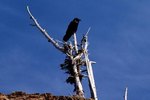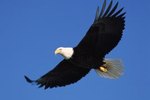
Also called chicken hawks, red-tailed hawks range throughout the United States and Canada. Those who summer in Canada fly south for the winter. Red-tails living further south don't migrate. Red-tailed hawks stay put for many years, flying only half a square mile to 2 square miles searching for food. While nesting, the females aggressively protect their babies. Very territorial, the males aggressively defend their areas. During disputes, the males dive steeply, talons extended, and swoop up and down repeatedly.
Hunting Behaviors
Red-tailed hawks spend much time hunting, and do so in two different ways: by soaring on thermal updrafts with eyes on the ground and by sitting on tall trees, waiting for prey to come by. They are often seen perching in trees or atop telephone poles, staring at the ground watching for prey. Sometimes mated pairs of red-tailed hawks attack as a team, cornering their victim.
Eating Behaviors
Red-tails eat fish, mice, rats, squirrels, rabbits, large insects and carrion stolen from other raptors. Sometimes they even eat other raptors. These hawks attack and eat smaller birds caught unaware while building nests or hunting for food. When it's cold, red-tailed hawks eat more than they do in warm weather, helping conserve body heat. When these birds molt, they sometimes eat less or stop eating altogether for a few days.
Flight Behavior
Red-tailed hawks seldom flap their wings while in flight. Instead they soar and ride the wind currents while conserving their energy for diving on prey. Red-tailed hawks don't hunch up while diving but stretch out and spread their legs out straight in attack posture. Red-tailed hawks usually fly at speeds of around 20 to 40 miles per hour -- but the top recorded flight speed is around 120 mph.
Courtship and Nesting Behaviors
Monogamous birds, red-tailed hawks pair for life. When breeding season begins, they share courtship flights marked by aerial displays including clasping talons to fall in spirals before breaking apart in spirals. The pair build a nest made from twigs and bark on a high place, which they use and remodel for years. Both the male and female help with nest building and incubation of two to three eggs, which lasts up to 32 days. The male hunts and the female feeds the young with prey he brings back to the nest. The young leave the nest after 46 days, then remain near the nest for nearly a month longer.
References
Photo Credits
-
John Foxx/Stockbyte/Getty Images



